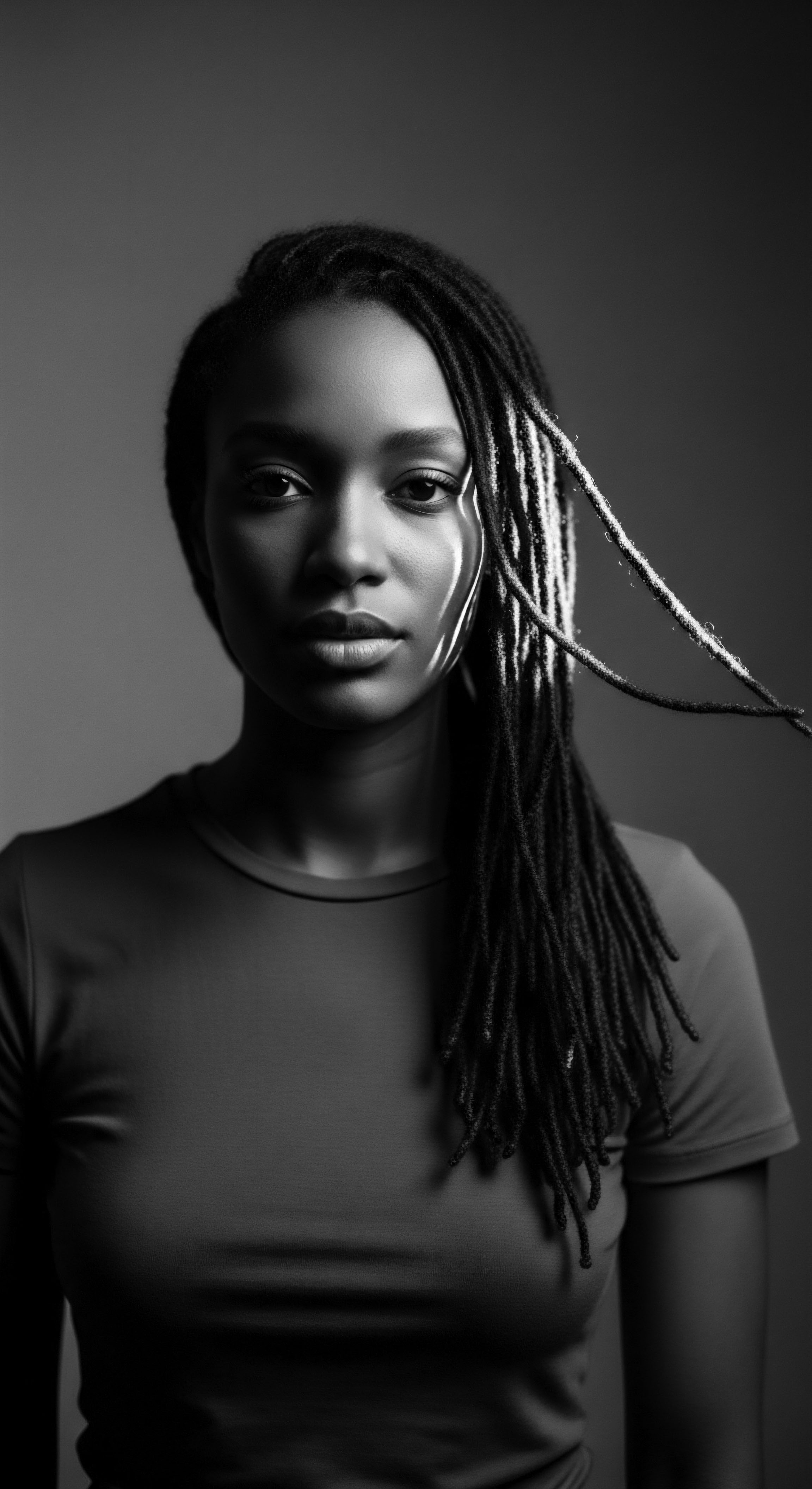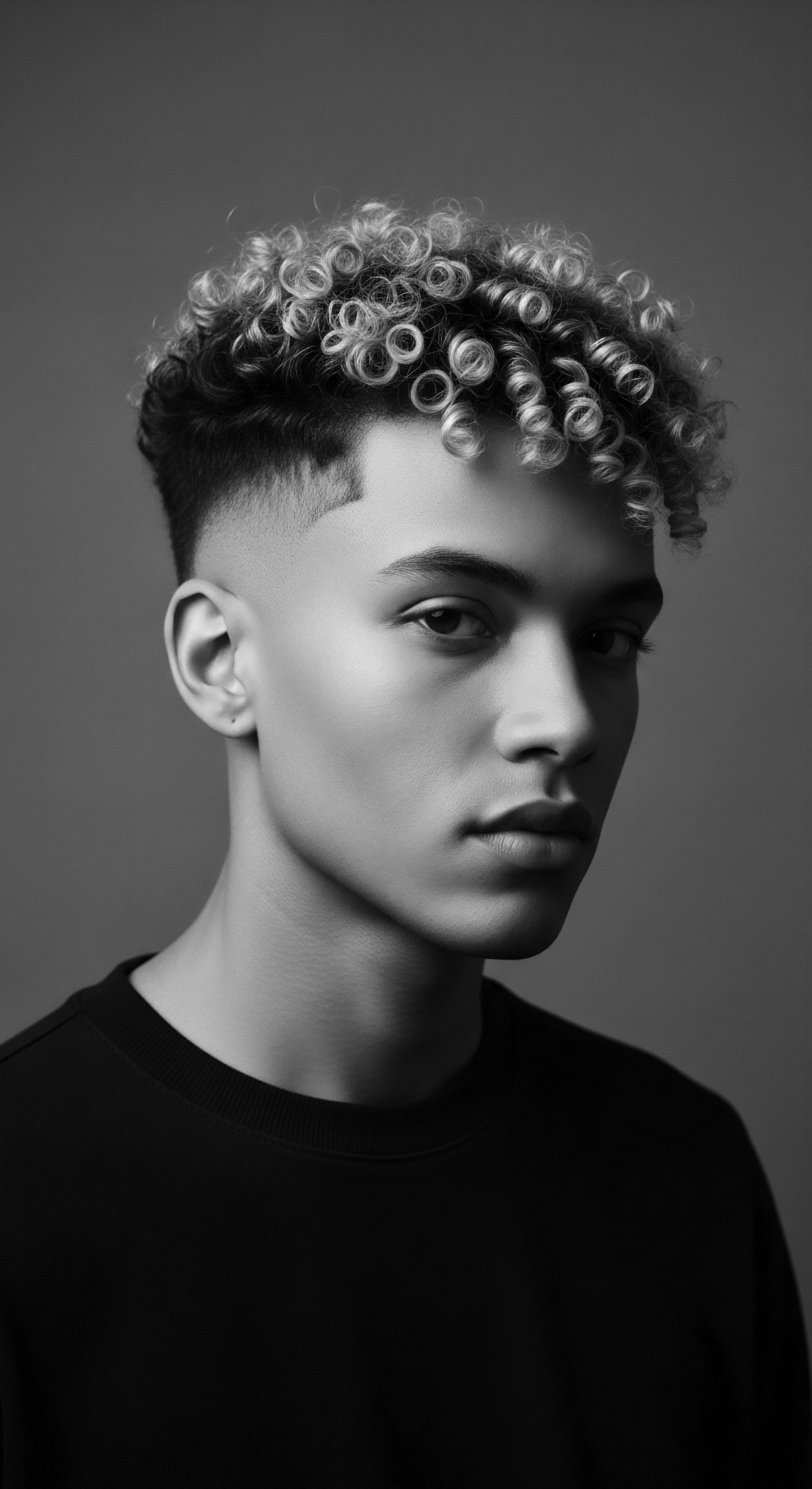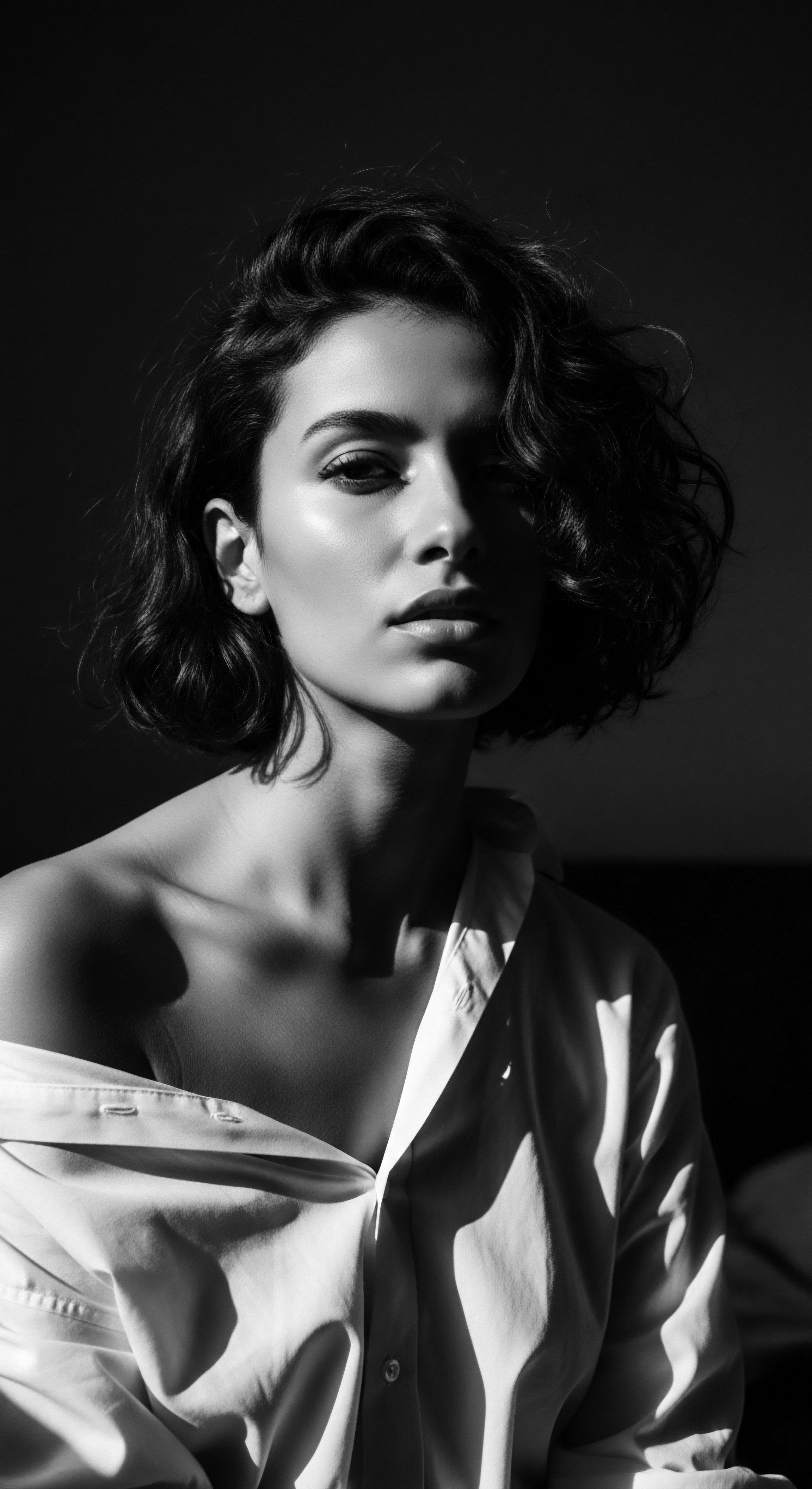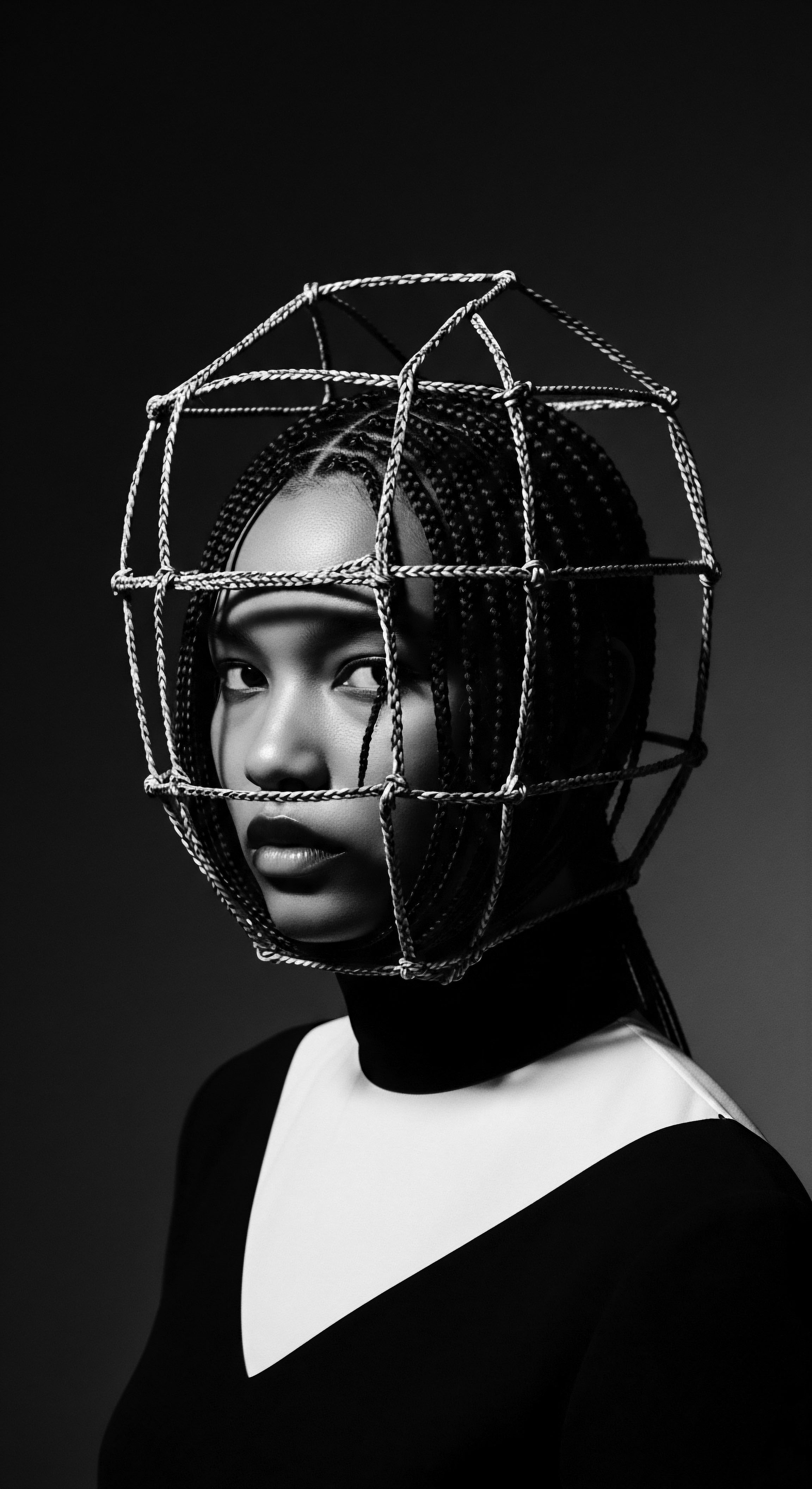
Roots
To stand on the threshold of textured hair’s grand story is to feel the stirring of millennia beneath one’s feet, a rhythmic pulse echoing from the earliest ancestral lands. This exploration of the historical role specific tools held in textured hair styling invites a reverence for the ingenuity and spirit of those who came before us. It is an invitation to witness how a simple instrument, shaped by hand and purpose, could become a conduit for identity, for community, and for a legacy of beauty that defies the erosion of time. We journey through these narratives not as mere observers, but as inheritors of a vibrant tradition, where each strand holds memory, and every styling act becomes a whisper of the past.
The very structure of textured hair itself, an architectural marvel of twists and turns, dictated the earliest approaches to its adornment and care. Consider the helical geometry of a tightly coiled strand, its delicate protein bonds and the natural inclination toward shrinkage. This biological reality, far from being a limitation, was the blueprint for innovation.
Ancient peoples, in their profound observation of the natural world and the human form, developed an intuitive understanding of this unique fiber. Their interaction with hair was a practical art, a science born of necessity, and a ritual steeped in spiritual significance.

How Did Hair’s Innate Biology Guide Early Styling?
The innate characteristics of textured hair – its varying degrees of curl, its propensity for volume, its need for moisture – naturally guided the creation of instruments designed to manipulate it. Early implements were not conceived in a vacuum; they arose from a deep, symbiotic relationship between the hair, the environment, and the human desire for order, beauty, and expression. Before any intricate pattern could be fashioned, there existed a primary challenge ❉ how to detangle, how to segment, how to maintain the health of the scalp and strands. This foundational need gave rise to some of the most enduring hair tools we know.
Across various civilizations, the earliest tools often stemmed from readily available natural elements. Thorns , sharpened bone fragments, or slivers of wood served as primitive picks, their pointed ends adept at separating matted sections. The abrasive quality of certain sands or finely ground minerals might have been used in rudimentary cleansing, while plant-based oils smoothed and offered pliability.
These were not tools in the modern sense of manufactured precision, rather extensions of the hand and mind, crafted with a knowledge that predated written history. Their existence speaks to a universal human drive for self-care and cultural expression, profoundly linked to the unique demands of textured hair.

What Materials Shaped the First Styling Instruments?
The materials available to ancestral communities directly shaped the forms and functions of their styling instruments. The choice was often dictated by local flora, fauna, and geology.
- Bone and Ivory ❉ These materials, obtained from animals, offered durability and could be meticulously carved into combs with varying tooth densities, suitable for detangling or creating fine parts. Such combs, sometimes adorned with symbolic motifs, served both practical and ritualistic purposes.
- Wood ❉ From readily accessible trees and shrubs, wood was shaped, smoothed, and sometimes oiled. Wooden combs, particularly those with wide teeth, are still valued today for their gentleness on fragile textured strands, minimizing breakage. Their historical application was widespread, adapting to the specific wood types available in different regions.
- Clay and Ceramics ❉ While less common for direct hair manipulation, baked clay forms or heated ceramic elements might have played a role in warming hair preparations or even in early attempts at straightening through indirect heat, though direct thermal application as we know it is a much later development.
- Vegetable Fibers ❉ Certain plant fibers were twisted and braided into cords, used perhaps as early hair ties or to section hair. They might also have formed rudimentary brushes or polishing tools, providing shine through friction.
The archaeological record offers poignant glimpses into these early practices. One notable example is the discovery of ancient combs, some dating back as far as 6,000 years, found in archaeological sites across Africa. For instance, intricately carved ivory combs from ancient Egypt, unearthed in burial chambers, testify to the significance of hair adornment and ritual. These combs were not merely functional; they were often symbols of status, beauty, and connection to the divine, reflecting a deep engagement with hair care as a heritage practice (Stevenson, 2018).
The foundational understanding of textured hair’s biology sparked an ancestral ingenuity, guiding the creation of early styling instruments from the very materials of the earth.
The meticulous work evident in these artifacts suggests a society that placed high value on personal presentation and the communal rituals surrounding hair. Such tools were not disposable items; they were often passed down through generations, acquiring stories and significance with each use. This tradition underscores a core aspect of textured hair heritage ❉ its continuity through lineage, where tools become tangible links to the past.

Ritual
The historical narrative of textured hair tools moves beyond mere function into the realm of ritual, where practical application merged seamlessly with spiritual meaning and social convention. For countless generations, the act of styling textured hair was not an isolated task; it was a deeply embedded cultural practice, a communal undertaking that bound individuals to their families, clans, and ancestors. The tools employed in these practices became extensions of this sacred bond, imbued with the significance of shared moments and inherited knowledge.
The creation of intricate hairstyles, whether braids, twists, or locs, often required hours of patient work, performed by skilled hands. During these lengthy sessions, stories were exchanged, wisdom transmitted, and bonds solidified. The combs, picks, and various implements used facilitated these interactions.
They were instruments of beauty, yet they were also instruments of cultural transmission , helping to sculpt not only hair but also communal memory and identity. This aspect is particularly poignant when considering the diasporic journey, where hair practices and their tools became vital threads connecting displaced peoples to their ancestral heritage.

How Did Tools Shape Communal Hair Styling Practices?
Communal hair styling, a hallmark of many African and diasporic cultures, relied on the symbiotic relationship between stylist, client, and the tools at hand. Imagine a scene ❉ a village elder, her hands adept from years of practice, uses a fine-toothed bone comb to section a young girl’s hair, preparing it for ceremonial braids. This comb, perhaps a family heirloom, guides not only the part but also the narrative of the styling session itself.
It is in these moments that the tool transcends its physical form, becoming a tangible link to heritage. The tools allowed for the precision needed to create complex patterns, often signifying status, age, marital status, or even tribal affiliation.
Consider the widespread use of the wooden parting stick or the braiding needle (often made from bone or wood). These simple implements were essential for creating neat, symmetrical sections – the foundation of many traditional textured hairstyles. The consistent use of such tools ensured uniformity and allowed for the replication of intricate designs passed down through oral tradition.
Without these basic, yet indispensable, instruments, the complex geometric patterns and sculptural forms that define so much of textured hair artistry would have been far more challenging, if not impossible, to achieve. They speak to a collective dedication to precision and aesthetic excellence that has defined textured hair styling for generations.
| Tool Category Wide-Tooth Combs |
| Historical Application (Heritage Focus) Used for gentle detangling of natural coils, preserving hair integrity during preparation for styling. Often carved from wood or horn. |
| Contemporary Relevance Still preferred for detangling textured hair wet or dry, minimizing breakage and maintaining curl pattern. |
| Tool Category Parting Sticks/Needles |
| Historical Application (Heritage Focus) Crafting precise sections for braids, twists, and intricate patterns, crucial for symbolic and aesthetic accuracy. |
| Contemporary Relevance Indispensable for neat parting in protective styling, ensuring clean lines and professional finishes. |
| Tool Category Hair Pins/Ornaments |
| Historical Application (Heritage Focus) Adorning and securing finished styles, often made from metal, bone, or shells, reflecting status or tribal identity. |
| Contemporary Relevance Decorative and functional, securing updos or adding embellishment to modern styles. |
| Tool Category These tools embody a continuing tradition, where ancestral wisdom meets contemporary needs in the care of textured hair. |

What Was the Connection Between Tools and Hair Adornment?
Beyond the shaping of hair, tools played a significant role in its adornment. Hair was not simply styled; it was often ornamented with cowrie shells, beads, metals, and textiles. Tools like needles or specialized awls (small, pointed tools) would have been necessary to pierce through braided sections or to thread delicate beads onto individual strands. This act of adornment was rarely purely decorative; each addition often carried symbolic weight, indicating social standing, wealth, or spiritual beliefs.
The historical record, particularly from regions like West Africa, shows a rich tradition of incorporating precious metals and stones into hairstyles. A specialized set of smaller, more delicate instruments would have been used for this work, requiring a level of precision that speaks to the artistry and value placed on hair as a canvas for expression. The tools enabled these intricate forms of self-expression, making hair a living sculpture, a dynamic statement of cultural belonging and personal narrative.
Styling tools, far from mere implements, became conduits for ritual, community, and the enduring transmission of cultural meaning across generations.
The legacy of these tools stretches into the present, influencing contemporary textured hair practices. The very techniques of braiding, twisting, and locking, which rely on the foundational ability to section and manipulate hair, find their origins in these early tool-assisted rituals. The reverence for these practices, the understanding of their heritage, remains a guiding principle in how many approach textured hair care today.

Relay
The journey of textured hair styling tools is a relay race through time, with each historical period passing the baton of innovation, adaptation, and cultural significance. From the ancient world, through periods of immense societal upheaval, to the complexities of modern identity, specific tools have consistently served as tangible markers of resilience, artistry, and self-determination. This continuous unfolding reveals how instruments designed for hair manipulation became agents of cultural continuity and, at times, instruments of resistance.
The transatlantic slave trade, a period of unimaginable disruption, presented immense challenges to the preservation of African hair traditions. Yet, even in the face of brutal oppression, the ingenuity of enslaved Africans persisted. While traditional, elaborate tools were often unavailable, necessity spurred adaptation. Simple items – a twig, a butter knife, a heated piece of metal – were repurposed, transforming into clandestine instruments for maintaining hair, a vital link to a stolen heritage.
The act of tending to hair, even with improvised tools, became a quiet defiance, a way to retain a semblance of identity and human dignity. This forced innovation is a poignant testament to the enduring power of textured hair heritage.

How Did Historical Oppression Influence Tool Adaptation?
During the era of slavery and subsequent systemic oppression, access to traditional tools was severely restricted. Yet, the deep-seated cultural significance of hair meant that its care and styling did not cease; rather, it transformed. Tools were often crude, fashioned from whatever was at hand. A heated iron comb , for instance, emerged as a means to alter hair texture, either for conformity or perceived manageability in a hostile environment (Byrd & Tharps, 2001, p.
57). While controversial, this specific tool’s history speaks to the extreme pressures faced by Black women and men, navigating a society that often demonized their natural hair. This adaptation, born of a desperate need to survive and sometimes to assimilate, represents a complex chapter in the heritage of textured hair tools. It highlights how the very instruments of styling could become symbols of both cultural endurance and forced conformity.
This period also saw the development of homemade concoctions and instruments, passed down through generations within tight-knit communities. For example, the creation of makeshift picks from straightened coat hangers or other metal scraps, used to lift and volumize hair, represents a powerful act of agency. These improvised tools, though lacking the aesthetic refinement of their ancestral counterparts, were deeply significant because they allowed for the continuation of practices that rooted individuals in their heritage, despite immense adversity. They underscore the resourcefulness and unbreakable spirit that defined the Black experience.
From ancient artistry to the crucible of oppression, tools for textured hair have consistently served as symbols of cultural continuity and tenacious self-expression.

What Scientific Principles Guided Later Tool Development?
As societies industrialized, the development of hair styling tools began to intersect with emerging scientific understanding. The late 19th and early 20th centuries saw the invention of commercially produced heating tools designed to straighten textured hair, building on earlier, cruder methods. These advancements were often framed as solutions for “managing” what was then deemed “unruly” hair, reflecting prevailing beauty standards and racial biases. The hot comb , patented by Madam C.J.
Walker in the early 20th century, stands as a prime example. While its purpose was often tied to assimilationist ideals, its introduction also democratized access to hair straightening for Black women, providing an unprecedented level of control over their appearance. This tool, steeped in complex heritage, allowed for new styling possibilities and contributed to an evolving understanding of hair manipulation.
The shift from open flame heating to electric appliances marked a significant technological leap. Early electric curling irons and then flat irons, though initially designed for straight hair, were adapted for textured hair. This period saw a rudimentary application of thermal science ❉ understanding how heat could temporarily alter the hydrogen bonds within the hair shaft to achieve a desired form. This scientific understanding, while sometimes leading to hair damage due to lack of temperature control, was a crucial step in the ongoing scientific study of hair’s response to external forces.
The latter half of the 20th century and into the 21st witnessed a profound re-embrace of natural textured hair. This shift in cultural perception spurred a new wave of tool innovation. The Afro pick, a tool whose form echoes ancient combs, became a symbol of Black pride and a staple for lifting and shaping natural hair. Its resurgence was not simply a return to an old form; it was a conscious cultural statement, reclaiming an aesthetic that had long been suppressed.
- The Afro Pick ❉ A tool with widely spaced, often long, tines, designed to lift and add volume to textured hair without disturbing the curl pattern. Its popularity soared during the Black Power movement of the 1960s and 70s, symbolizing cultural identity.
- Detangling Brushes ❉ Modern iterations, often with flexible bristles and ergonomic designs, build upon the principle of gentle hair separation, a direct descendent of the wide-tooth comb. These tools seek to minimize friction and breakage on delicate coils.
- Diffusers ❉ Attachments for blow dryers that disperse airflow, preventing frizz and preserving curl definition. They apply a controlled, gentle heat, a stark contrast to the intense direct heat of earlier straightening methods, reflecting a scientific understanding of textured hair’s drying process.
These contemporary tools, while employing modern materials and technologies, ultimately serve the same fundamental purposes as their ancestral counterparts ❉ to cleanse, to detangle, to style, and to adorn. They continue the relay, each generation shaping tools that honor the heritage of textured hair while adapting to its evolving needs and expressions.

Reflection
To contemplate the tools of textured hair styling through the ages is to witness a profound journey of adaptation, ingenuity, and unwavering spirit. Each comb, each pick, each simple stick speaks to a deep connection to lineage, a continuity that defies rupture. The instruments, whether ancient bone carvings or modern ergonomic designs, are not simply objects; they are vessels carrying the whispers of ancestral hands, the rhythm of communal gatherings, and the quiet triumphs of self-reclamation. They remind us that the care and styling of textured hair is, at its heart, a practice of remembering, a living archive where every curl and coil holds a story, every practiced hand motion a testament to enduring heritage.
This exploration reveals that textured hair heritage is a dynamic, resilient force, constantly re-shaping itself yet always holding firm to its roots. The tools, through their very existence and evolution, underscore the sacred nature of textured hair ❉ a testament to identity, a canvas for self-expression, and a powerful symbol of beauty maintained across generations. We, as inheritors of this tradition, hold the responsibility to honor these legacies, understanding that the implements we choose today are part of a continuing dialogue with a rich and storied past. The soul of a strand, indeed, continues to sing through the enduring presence of these humble, yet mighty, instruments.

References
- Byrd, A. D. & Tharps, L. D. (2001). Hair Story ❉ Untangling the Roots of Black Hair in America. St. Martin’s Griffin.
- Stevenson, J. (2018). The Science of Black Hair ❉ A Comprehensive Guide to Textured Hair Care. J. Stevenson.
